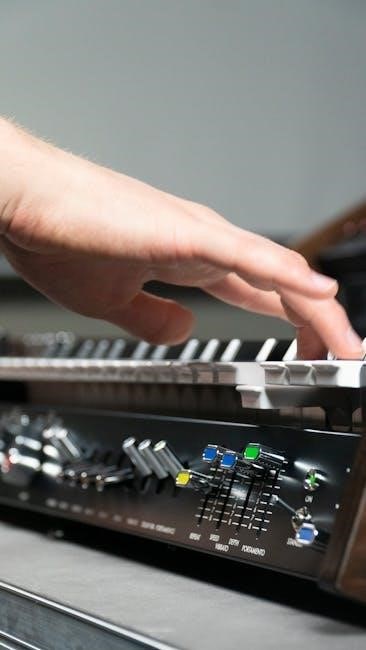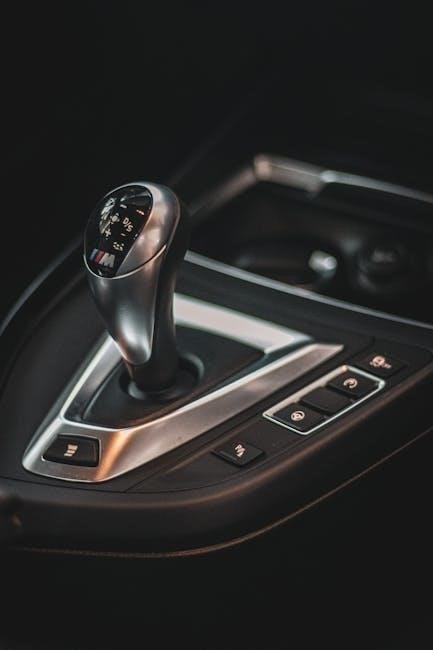A sequential manual transmission, or sequential gearbox, is a non-synchronous manual transmission designed for high-performance vehicles, primarily used in racing and motorcycles. It offers faster gear shifts compared to traditional manual transmissions by limiting gear selection to a linear sequence, eliminating the need for an H-pattern gear layout. This design enhances speed and precision, making it ideal for competitive environments where quick shifting is critical. The sequential gearbox simplifies the shifting process, reducing driver fatigue and enabling smoother transitions between gears, particularly in high-stakes racing conditions.
Definition and Overview
A sequential manual transmission, commonly known as a sequential gearbox, is a type of non-synchronous manual transmission that allows drivers to shift gears in a linear sequence. Unlike traditional manual transmissions, which use an H-pattern gear selector, sequential gearboxes enable shifting by moving the lever or paddles forward or backward in a straight line. This design eliminates the need to navigate through intermediate gears, enabling faster and more precise gear changes. It is widely used in high-performance vehicles, motorcycles, and racing cars due to its simplicity, speed, and ease of operation.
History and Development
The sequential manual transmission has its roots in early motorcycle transmissions, where linear gear shifting was first introduced for simplicity and speed. Over time, this concept evolved and was adopted by the automotive industry, particularly in racing, where quick shifts were crucial for performance. The development of sequential gearboxes accelerated in the mid-20th century, with advancements in materials and engineering leading to modern designs that prioritize speed, durability, and driver control. Today, sequential gearboxes are a cornerstone in motorsports and high-performance vehicles.
Common Applications
Sequential manual gearboxes are predominantly used in high-performance environments, such as racing cars, motorcycles, and Formula 1 vehicles, where rapid gear shifts are critical. They are also popular in motorsports for their ability to enhance speed and precision. Additionally, sequential gearboxes are often adapted for use in street-legal cars through aftermarket conversion kits, offering drivers a blend of racing performance and everyday usability. Their compact design and linear shifting mechanism make them ideal for applications requiring quick, precise gear changes and minimal driver input.
Mechanism of Sequential Gearbox
A sequential gearbox operates through a linear shifting mechanism, using paddles or a lever to select gears in a fixed order, eliminating the H-pattern of traditional manuals.
How It Differs from Traditional Manual Transmissions
A sequential gearbox differs from traditional manual transmissions by eliminating the H-pattern gear layout, instead using a linear shifting mechanism. Gears are selected in a fixed order, either up or down, without the need to navigate through a complex pattern. This design reduces shifting time and simplifies the process, as the driver only needs to push or pull the lever to change gears. Unlike traditional manuals, sequential gearboxes often lack synchronization, requiring precise driver input to match speeds, but this trade-off enables faster and more precise shifts, making them ideal for high-performance applications like racing.
Linear Gear Shifting Explained
Linear gear shifting in a sequential gearbox involves a straightforward, sequential selection of gears in a fixed order. Unlike traditional manual transmissions that use an H-pattern, sequential gearboxes allow drivers to shift gears by simply moving the lever forward or backward in a straight line. This eliminates the need to navigate through a complex pattern, enabling faster and more intuitive gear changes. The driver can only shift to the next higher or lower gear in sequence, streamlining the process and reducing the risk of errors during high-speed driving or racing conditions.
Role of Clutch and Gear Actuation
In a sequential gearbox, the clutch plays a crucial role in disengaging the engine from the current gear, allowing smooth transitions between gears. While traditional manual transmissions require manual clutch engagement, some sequential systems automate this process. Gear actuation is typically handled by a hydraulic or electronic system, enabling rapid and precise shifts. The clutch and actuation work in tandem to minimize gear grinding and ensure seamless power delivery, making the system highly efficient for high-performance applications like racing, where quick and exact gear changes are essential for optimal performance.
Components Involved
A sequential gearbox comprises several key components, including the gearbox casing, which houses the gears arranged in a straight line. The shift fork and selector mechanism enable gear changes by moving along the linear gear shaft. Actuation systems, such as hydraulic or electronic controls, manage the engagement and disengagement of gears. The clutch, often automated in modern systems, is essential for seamless transitions. Bearings and gear synchronizers (or their absence in unsynchronized types) also play critical roles in the functionality of the sequential gearbox, ensuring smooth and precise operation.
Benefits of Sequential Gearbox Manual
Sequential gearboxes offer faster gear shifts, reducing driver fatigue and enhancing performance in racing. They prevent gear jumping and provide smooth, precise transitions, ideal for high-performance applications.
Faster Gear Shifts
Sequential gearboxes deliver faster gear shifts compared to traditional manual transmissions. By eliminating the need to navigate an H-pattern, drivers can shift gears in a linear sequence, reducing the time and effort required. This linear shifting mechanism minimizes the complexity of gear selection, allowing for quicker transitions between gears. The simplified process enables drivers to maintain focus on the road or track, making it particularly advantageous in high-performance and racing environments where split-second decisions are crucial.
Reduced Driver Fatigue
Sequential gearboxes significantly reduce driver fatigue by simplifying the shifting process. The linear gear selection eliminates the need for complex H-pattern movements, making shifts easier and less physically demanding. This design reduces mental and physical strain, especially during extended driving sessions or high-intensity racing. Additionally, the sequential mechanism minimizes the effort required to engage gears, allowing drivers to maintain focus and stamina over time. This makes it particularly beneficial for long drives or competitive racing environments where driver endurance is crucial.
Enhanced Performance in Racing
Sequential gearboxes excel in racing environments by delivering rapid, precise gear shifts that maximize acceleration and control. The linear shifting mechanism eliminates the need for an H-pattern, reducing shift times and enabling drivers to maintain focus on the track. This design enhances responsiveness, particularly during high-speed cornering and overtaking. The lightweight construction of sequential gearboxes also improves power-to-weight ratios, further boosting performance. These features make sequential gearboxes a preferred choice for racers seeking optimal speed, agility, and reliability in competitive settings.
Prevention of Gear Jumping
Sequential gearboxes effectively prevent gear jumping through their linear engagement mechanism. Unlike traditional manual transmissions, where mishifting can occur due to incorrect gear selection, sequential systems only allow shifting to the next or previous gear. This design reduces the likelihood of accidental jumps, ensuring smoother and more controlled transitions. The direct, sequential nature of the gears minimizes mechanical wear and enhances driver confidence, making it particularly beneficial in high-performance applications where precision and reliability are critical.

Types of Sequential Gearboxes
Sequential gearboxes are categorized into three main types: unsynchronized, constant mesh, and automated manual transmissions, each offering unique performance characteristics for specific applications.
Unsynchronized Transmission
An unsynchronized transmission is the simplest form of sequential gearbox, lacking synchronizers to match gear speeds. This design requires manual coordination by the driver to ensure smooth shifts, making it less common in modern vehicles but still used in niche racing applications where weight reduction and simplicity are prioritized. The absence of synchronizers reduces mechanical complexity and weight, contributing to faster gear changes in expert hands, though it demands precise driver input to avoid gear damage or grinding.
Constant Mesh Gearbox
A constant mesh gearbox is a type of sequential transmission where gears remain in constant contact, enabling rapid shifts without waiting for engagement. This design eliminates the need for synchronization, allowing drivers to change gears quickly and smoothly. While it offers faster shifting, it can produce gear noise when gears are not actively engaged, making it a popular choice for high-performance applications despite this minor drawback.
Automated Manual Transmission
An automated manual transmission (AMT) combines elements of manual and automatic transmissions, using electronic or hydraulic systems to automate clutch engagement and gear shifts. Unlike traditional manual transmissions, it eliminates the need for a clutch pedal, offering a semi-automatic experience. AMTs are often found in production cars, such as the BMW SMG system, and provide faster shifting than conventional manuals while maintaining fuel efficiency. However, they may lack the precision and driver control of a purely manual sequential gearbox.

Installation and Setup
Installation of a sequential gearbox often requires specialized conversion kits, such as those offered by Alfaholics, to adapt the system to street-legal vehicles. Professional expertise is recommended due to complex modifications involving electrical, mechanical, and hydraulic components.
Conversion Kits for Street-Legal Cars
Conversion kits enable sequential gearboxes to be installed in street-legal vehicles, offering a performance upgrade for enthusiasts. Companies like Alfaholics provide tailored solutions for specific models, such as classic Alfa Romeos, with ready-built units or DIY kits. These kits typically include adapted gearsets, modified linkages, and necessary electronics to integrate with the vehicle’s existing systems. While installation requires mechanical expertise, it allows drivers to experience the precision and speed of a sequential gearbox in a road-going car, blending race-like performance with everyday usability.
Aftermarket Solutions
The aftermarket offers a variety of sequential gearbox solutions tailored for specific vehicles, enhancing performance and driving experience. Companies like Quaife specialize in producing high-quality sequential gearboxes for racing and street use, offering five, six, and seven-speed options. These solutions cater to diverse needs, from Motorsport applications to daily driving, providing faster shifting and improved durability. Aftermarket sequential gearboxes often include advanced features like electronic actuation and adaptive software, making them versatile for both enthusiasts and professional racers. This growing market meets the demand for high-performance, customizable transmissions globally.
Specific Examples (e.g., BMW SMG, Alfaholics)
Prominent examples of sequential gearboxes include the BMW SMG (Sequential Manual Gearbox) and Alfaholics’ custom units. BMW’s SMG, featured in the E46 M3, combines manual control with electronic actuation for precise shifts. Alfaholics offers bespoke sequential gearboxes for classic Alfa Romeos, blending vintage aesthetics with modern performance. These examples showcase how sequential technology enhances driving dynamics, offering faster, smoother shifts while maintaining driver engagement. They cater to enthusiasts seeking high-performance without sacrificing the joy of manual driving.
Maintenance and Care
Regular servicing is crucial for sequential gearboxes, including fluid checks and clutch inspections. Proper lubrication and timely component replacements ensure optimal performance and longevity of the transmission system.
Regular Servicing Requirements
Regular servicing is essential to maintain the performance and longevity of a sequential gearbox. This includes checking gearbox oil levels, inspecting the clutch, and ensuring proper lubrication of moving parts. The gear actuation system should be serviced periodically to prevent wear and tear. Adhering to the manufacturer’s recommended service intervals is crucial to avoid premature component failure. Proper maintenance ensures smooth operation, prevents gear jumping, and extends the lifespan of the transmission system. Regular checks by a qualified technician are highly recommended.
Tips for Longevity
To ensure the longevity of a sequential gearbox, avoid aggressive shifting and always use the clutch smoothly. Regular oil changes with high-quality transmission fluid are vital. Inspect the gear actuation system for wear and replace components as needed. Avoid riding the clutch, as this can cause unnecessary stress on the transmission. Store the vehicle in a dry environment to prevent corrosion. Proper alignment of the gear lever and linkage is also essential to maintain optimal performance and reduce wear on internal components over time.
Troubleshooting Common Issues
Common issues with sequential gearboxes include difficulty shifting gears, which may indicate worn clutch components or low transmission fluid levels. Grinding noises during shifts often point to improperly engaged gears or damaged synchronizers. Leaks around the gear lever or casing can signal worn seals or gasket failures. Regular inspection of the clutch and gear actuation system is essential to identify wear early. Addressing these issues promptly prevents further damage and ensures smooth operation. Always consult a specialist for complex repairs to maintain performance and longevity.

Comparison with Other Transmissions
Sequential gearboxes offer faster shifts and simpler operation compared to traditional manuals, while dual-clutch transmissions provide similar speed but with automatic functionality, catering to different driver preferences and performance needs.
vs. Traditional Manual Transmission
A sequential gearbox differs from a traditional manual transmission by offering faster gear shifts and a simpler, linear gear selection process. Unlike the H-pattern of manual transmissions, sequential gearboxes allow only forward or backward gear progression, eliminating the need to navigate through intermediate gears. This design reduces driver fatigue and minimizes traction loss during shifts. Additionally, sequential gearboxes often automate the clutch function, streamlining the shifting process and enabling quicker transitions between gears, making them particularly advantageous in racing and high-performance applications where speed and precision are critical.
vs. Automated Manual Transmission
While both sequential and automated manual transmissions offer faster shifting than traditional manuals, they differ in operation. Sequential gearboxes require manual gear selection via a lever or paddles, with no automatic shifting. Automated manuals, however, use electronic actuators to automatically engage and disengage the clutch and gears, reducing driver input. Sequential gearboxes are typically lighter, simpler, and more performance-oriented, while automated manuals prioritize convenience and ease of use, making them better suited for everyday driving rather than racing applications.
vs. Dual-Clutch Transmission
Sequential gearboxes differ from dual-clutch transmissions (DCTs) in their mechanical simplicity and operation. DCTs use two clutches to pre-select gears, enabling instantaneous shifts without torque interruption, making them faster in everyday driving. Sequential gearboxes, while rapid, require manual actuation of the clutch and gear lever or paddles, offering a more driver-engaged experience. DCTs are more complex, heavier, and often more expensive, whereas sequential gearboxes are favored in racing for their lightweight and direct control, sacrificing some convenience for enhanced performance and reliability in high-stress environments.

Case Studies and Examples
Sequential gearboxes are commonly used in motorcycles, racing cars, and high-performance vehicles. Examples include the BMW SMG and Alfaholics conversion kits for enhanced driving experiences.
Use in Motorcycles
Sequential gearboxes are widely used in motorcycles for their simplicity and efficiency. By allowing riders to shift gears in a linear sequence, they reduce fatigue and enable quicker transitions. This design is particularly beneficial in competitive racing, where precise control and rapid acceleration are crucial. Motorcycles equipped with sequential gearboxes often demonstrate enhanced performance, making them a preferred choice for both professional racers and enthusiasts seeking improved handling and responsiveness on the track.
Application in Formula 1
Formula 1 cars utilize advanced sequential gearboxes to optimize performance and speed. These systems, often semi-automatic, feature multi-plate clutches and paddle shifters for rapid, precise gear changes. The sequential design eliminates the need for a traditional clutch pedal, streamlining driver input and reducing lap times. This technology enables seamless acceleration and deceleration, critical in high-stakes racing environments. While highly specialized, F1’s use of sequential gearboxes demonstrates their potential for enhancing vehicle performance in extreme conditions.
Usage in NASCAR
NASCAR Cup Series cars employ five-speed sequential manual transmissions, offering precise control and rapid shifting. These gearboxes enhance acceleration and cornering, crucial in stock car racing. Unlike automatics used elsewhere, NASCAR’s sequential transmissions maintain driver engagement, providing a competitive edge. This setup balances performance with durability, ensuring reliability over long races. The use of sequential gearboxes in NASCAR highlights their adaptability to high-performance, competitive environments, blending manual control with optimized gear shifting.
Sequential gearboxes offer faster shifts, precision, and reduced driver fatigue, making them ideal for high-performance racing and motorcycles, while also serving as a cost-effective alternative to automatic transmissions.
A sequential gearbox offers faster, precise shifts and reduces driver fatigue by eliminating the H-pattern, ideal for high-performance racing and motorcycles. Its linear gear selection simplifies shifting, enhancing speed and control. Commonly used in competitive environments, it provides smoother transitions and is favored for its simplicity and efficiency. Examples include the BMW SMG and aftermarket kits like Alfaholics, showcasing its versatility and popularity in both racing and street-legal applications.
Future Prospects
Sequential gearboxes are expected to gain wider adoption in high-performance vehicles due to their efficiency and speed. Advances in materials and technology will likely lead to lighter and more durable designs, enhancing performance further. Integration with hybrid and electric powertrains could also emerge, maintaining the engagement of manual shifting while improving efficiency. Additionally, advancements in automation may blur the line between sequential and traditional transmissions, offering drivers the best of both worlds in terms of control and convenience.
Final Thoughts
Sequential gearboxes represent a significant leap in transmission technology, blending precision, speed, and driver engagement. Their widespread adoption in racing and high-performance vehicles underscores their importance in competitive environments. As automotive innovation progresses, sequential gearboxes may become more accessible to everyday drivers, offering a balance between performance and practicality; Their ability to deliver faster shifts and reduce driver fatigue makes them a preferred choice for enthusiasts seeking an immersive driving experience without compromising on efficiency.

References and Further Reading
For deeper insights, explore technical documentation from manufacturers like Quaife and BMW, or examine the BMW E46 M3’s SMG system for practical applications.
Recommended Resources
For comprehensive understanding, refer to manufacturer documentation from Quaife and BMW, detailing their sequential gearbox systems. Explore the BMW E46 M3’s SMG system for real-world applications. Technical guides from Alfaholics and S1 Sequential Pty Ltd provide hands-on insights. Additionally, online forums and specialized automotive journals offer practical advice and performance comparisons. These resources collectively provide a detailed understanding of sequential gearbox design, installation, and maintenance, catering to both enthusiasts and professionals.
Technical Documentation
Technical documentation for sequential gearboxes includes detailed diagrams, exploded views, and step-by-step guides for installation, maintenance, and troubleshooting. Quaife’s motorsport gearbox manuals provide specifications and torque settings, while BMW’s SMG system documentation outlines hydraulic and electronic controls. Alfaholics’ technical guides offer insights into retrofitting sequential gearboxes into classic vehicles. These resources are essential for engineers, technicians, and enthusiasts seeking to understand and work with sequential transmissions effectively.
Expert Opinions and Reviews
Experts highlight the sequential gearbox’s exceptional performance, with faster and smoother shifts compared to traditional manuals. Racing engineers praise its precision and reliability under high stress. Many enthusiasts appreciate the elimination of gear hunting and reduced driver fatigue. However, some note the higher cost and complexity of maintenance. Overall, specialists endorse sequential gearboxes for their superior speed and efficiency, making them ideal for competitive racing and high-performance applications where milliseconds count. Expert reviews consistently emphasize their value in professional motorsport settings.